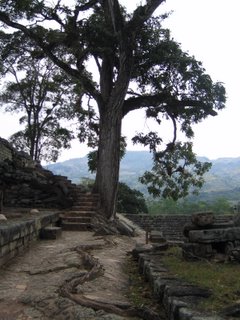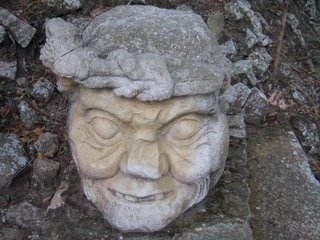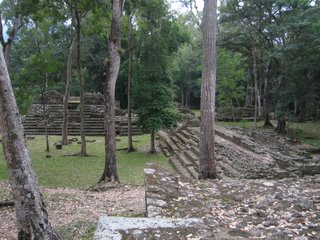Copan Ruinas

We awoke at 5 am on the 25th to get on a boat to Panajachel (also known as gringo-ville) to get on a shuttle to drive us for 6 hours across Guatemala to the Honduran border and just to the other side to the Mayan ruins of the great city of Copan. Half way across the lake, I notced some thin, cotton ball shaped clowds that I had high hopes for as the sun rose, and I wasn't dissapointed. On the far side of the lake, we were greeted by a spectacular sunrise which reached its peak at the exact moment we arrived at the look-out point maybe a kilometer above the lake. Small clouds dotted the entire eastern sky, each one fantastically pink, spread between towering volcanoes and reflected on the still morning water. Then we slept the rest of the way to Copan. Copan was a major Mayan center for only 400 years before the land was so depleted and the forests so demolished that they had to jump ship. The ruins stretch over 24 square kilometers, with three central plazas surrounded by towering pyramids with hundred year old trees growing out of them. We are greeted at the gates by a flock of tame macaws; their red, yellow and blue markings were sacred to the maya and represented the underworld, the world we live in and the heavens. In the ancient maya cosmology, everything in the physical world could be linked to the heavens or to the underworld with the help of the nobles, the priests or the king. They believed in the power the king and his connection with the cosmos so strongly that they considered him to be responsible for making the sun rise every morning. It was this kind of devotion that kept their society in its strict hierarchy - if the peasants didn't provide the food for the upper classes, it was entirely
 possible that the sun wouldn't rise again. There is one plaza in Copan surrounded on four sides by pyramid shaped temples. It used to be coated in stucco and painted red. There is a water main on one side and a drain on the other. When water was let in, the plaza was flooded with a shallow pool. Rising from the center rose another small pyramid. Archeologists surmise that they would flood this pool before dawn, where the stars would be reflected, thus symbolically bringing the cosmos down to the earth. The king would stand atop the central pyramid and usher in the rising of the sun. Imagine him dressed as the kings are carved on the stellae - jade breast piece, jade bracelets, tall crown, jaguar pelt hanging from loin to feet, boots made of jaguar with faces on each shin - arms outstreched to raise the sun from the underworld. And as the sun rises, the water in the pool is drained, the cosmos are gone into the underworld for the day and the king has lived up to his promise to raise the sun once again. The king also made promises that there would always be good harvests during each year of his reign, which led to occasional problems. One more ritual that took place in the same red stucco plaza is too morbid and interesting for me to resist describing. They have found two large stones carved with rounded bottoms and holes to support.... banners? With the rounded bottoms on the stucco floor of the plaza, they would have rolled. Another theory: The stones were part of a ritual for bringing fertility to the coming maize harvest, a ritual that coincided with the burning of the maize from the previous year's harvest. The holes in the stones would be used to support a scaffold onto which a prisoner, painted blue, would be tied. He would wear a backpack of pitch pine (a very incendiary form of pine tree). The floor below him would be covered in paper. Priests would shoot him with small arrows that would only superficially pierce the skin, allowing blood to drip onto the paper below but not kill the prisoner. This agony would cause
possible that the sun wouldn't rise again. There is one plaza in Copan surrounded on four sides by pyramid shaped temples. It used to be coated in stucco and painted red. There is a water main on one side and a drain on the other. When water was let in, the plaza was flooded with a shallow pool. Rising from the center rose another small pyramid. Archeologists surmise that they would flood this pool before dawn, where the stars would be reflected, thus symbolically bringing the cosmos down to the earth. The king would stand atop the central pyramid and usher in the rising of the sun. Imagine him dressed as the kings are carved on the stellae - jade breast piece, jade bracelets, tall crown, jaguar pelt hanging from loin to feet, boots made of jaguar with faces on each shin - arms outstreched to raise the sun from the underworld. And as the sun rises, the water in the pool is drained, the cosmos are gone into the underworld for the day and the king has lived up to his promise to raise the sun once again. The king also made promises that there would always be good harvests during each year of his reign, which led to occasional problems. One more ritual that took place in the same red stucco plaza is too morbid and interesting for me to resist describing. They have found two large stones carved with rounded bottoms and holes to support.... banners? With the rounded bottoms on the stucco floor of the plaza, they would have rolled. Another theory: The stones were part of a ritual for bringing fertility to the coming maize harvest, a ritual that coincided with the burning of the maize from the previous year's harvest. The holes in the stones would be used to support a scaffold onto which a prisoner, painted blue, would be tied. He would wear a backpack of pitch pine (a very incendiary form of pine tree). The floor below him would be covered in paper. Priests would shoot him with small arrows that would only superficially pierce the skin, allowing blood to drip onto the paper below but not kill the prisoner. This agony would cause him to writhe, moving the round-bottomed stones, and grinding them on the stucco, creating a thundering noise throughout the plaza - imagine the colors, the red plaza, the paper covered in blood, the blue prisoner screaming and twisting on the scaffold. When it was the right time, the priests would lower him to the ground and burn both the prisoner and the papers, using the pitch-pine backpack as kindling. The maya gave their blood in honor to the gods, and also gave other people's blood, with and without their consent. This offering of blood was to ensure the fertility of the new crop, like an exchange, and it was burned to carry the offering up to the heavens. So, I've gotten this information from an interesting looking guy who my dad spotted touring the ruins with a group of Brits. He seemed to be the quintessential archeologist - wide safari hat, khakis, button-down short sleeve shirt, practical shoes, fishing vest (or probably an archeology vest, in which he kept schematics, blueprints, photos and maps) and to top it all off, he had glasses and a bushy mustache. And, as it turned out, he was one of the lead archeologists of a certain temple in the Copan ruins. I spotted my dad trailing this group around, and I set off with them too, to learn these gory and fascinating details of religious life, which was decidedly not separate from "secular life," in the height of the mayan empire. The current maya religion does include sacrificing chickens, but their way of life in this time (as a suppressed people, not the ruling poeples they were before the spanish conquest) is decidedly more peaceful, and has also incorporated catholicism without losing the mayan religion.
him to writhe, moving the round-bottomed stones, and grinding them on the stucco, creating a thundering noise throughout the plaza - imagine the colors, the red plaza, the paper covered in blood, the blue prisoner screaming and twisting on the scaffold. When it was the right time, the priests would lower him to the ground and burn both the prisoner and the papers, using the pitch-pine backpack as kindling. The maya gave their blood in honor to the gods, and also gave other people's blood, with and without their consent. This offering of blood was to ensure the fertility of the new crop, like an exchange, and it was burned to carry the offering up to the heavens. So, I've gotten this information from an interesting looking guy who my dad spotted touring the ruins with a group of Brits. He seemed to be the quintessential archeologist - wide safari hat, khakis, button-down short sleeve shirt, practical shoes, fishing vest (or probably an archeology vest, in which he kept schematics, blueprints, photos and maps) and to top it all off, he had glasses and a bushy mustache. And, as it turned out, he was one of the lead archeologists of a certain temple in the Copan ruins. I spotted my dad trailing this group around, and I set off with them too, to learn these gory and fascinating details of religious life, which was decidedly not separate from "secular life," in the height of the mayan empire. The current maya religion does include sacrificing chickens, but their way of life in this time (as a suppressed people, not the ruling poeples they were before the spanish conquest) is decidedly more peaceful, and has also incorporated catholicism without losing the mayan religion.-Sarah

0 Comments:
Post a Comment
<< Home